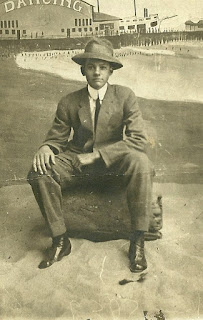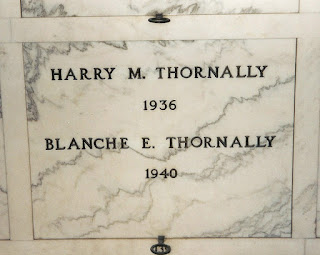Elmer was the eighth child born to Carrie and James W.
Pattillo. Their first two children – Wirt W.
and James H. both died as infants.
Wirt and James were born in Tarrant County, Texas as were Jo and Mary Pattillo
- the next two children who lived to adulthood. Next was Lewis Wood, my
grandfather and then the twins Maude and Ruby. Elmer was born on November 13,
1895. Elmer, Lewis, Maude and Ruby were all born after the family had moved to
Los Angeles, California. |
| Elmer with his father James William |
Elmer was four years old on June 1, 1900 when the census
was taken. At that time they were living on Jefferson Street in Los Angeles.
Ten years later in 1910 they were at 1176 West 37th Place, Los
Angeles. Elmer’s father was supporting the family as the owner of JW Pattillo & Company – a business that
laid and finished concrete. In 1914, City Directories gave Elmer’s address as
1309 W. 51st Place in San Pedro and noted that at 19 he was working
as a contractor – it is likely we was working for his father in the concrete
finishing business, as his older brother Lewis was. Years later Lewis’ son Bert
adopted the same profession, so we have three generations of concrete finishers
in our family.
 |
| Elmer with his brother Lewis Wood |
On June 15, 1917 when Elmer was 21, he filled out his
draft registration for WWI. At that time he was living at 3919 South Vermont
Avenue in Los Angles. He listed his occupation as a farmer, which is odd. Though
many of Elmer’s ancestors were farmers and tobacco growers he and his father
and siblings were all tradesmen – not farmers. Presumable in an effort to avoid
the draft he claimed he was the sole support for his father on his draft registration.
It was probably true because his father James was 69 and had retired. The claim
did not work though - Elmer did serve in the Navy for a short time though I
know no details of his military service.
The 1917 directory showed Elmer’s occupation as a clerk but it does not provide a business name or
address. Elmer was still living on South Vermont in 1918, but by 1919 he had
moved to Fresno and was living with his sister Maude and her husband Otto Baty
at 3406 Nevada Street.
When he was 24, Elmer married Winifred Augusta Lutz on
December 15, 1919. Winifred was the daughter
of Nellie Ruth Miller and John Edward Lutz.
Winifred’s Family
Nellie was the daughter of William E. Miller and Augusta
May. She was born in the town of Auburn in Placer County, California in 1863 or
1864. Her family moved to San Francisco when she was 7 and two years later to
Oakland. On December 18, 1890 she married John E. Lutz. Nellie was described as
“a good wife, a sweet, gentle mother and the one who took up the burden of a
little community and household…. Nellie Lutz was a heroine of the home”. She
was a member of the Christian Science Church. She died of pneumonia on November
25, 1940. At that time she and John were living at 516 31st Street
in Oakland.
 |
| Winifred A. Lutz & Elmer |
Nellie’s father, William E. Miller was a native of
Baltimore who arrived in California in 1949, so he was considered a pioneer. He owned the Oakland Bank of Savings that was located on Broadway at 10th
Street in downtown Oakland. Nellie’s mother Augusta was born May 12, 1836 in
New York. Her family arrived in California in 1851. William and Augusta were
married in Sacramento on April 20, 1853. Nellie
had two older sisters Lillian and Mary. Lillian married Henry C. McPike and
they had 3 children – a daughter Hazel and sons Belden and Grayson. Mary was an
invalid and may not have married.
When William died in 1895 he left his estate to his three
daughters. That included the property at Broadway and 10th Street
where the Oakland Bank of Savings was
located. It also included two other parcels – one that fronted on Webster and
had a residence on it, and the third was on Franklin near 14th
Street.
 |
| Oakland Bank of Savings at Broadway & 10th Street |
On January 11, 1902 John and Nellie Lutz and Nellie’s
sister Lillian and her husband Henry C. McPike sold the Broadway and 10th
property that the sisters had inherited from her father, to the Oakland Bank of
Savings for $46,000. In February of the same year they took out a loan for
$10,000 from Oakland Bank of Savings using the building as collateral. A
February 26, 1902 headline claimed “They Want To Divide the Miller Estate” –
the 3 parcels described above. Another news article dated June 18, 1902
reported that the bank at Broadway and 10th was then known as the First National Bank. On February 4, 1906
The First National Bank announced plans to build a five-story building on the
gore lot at Broadway and San Pablo Avenue, near 14th Street. The
site at Broadway and 10th was sold to Laura M. Taylor for $130,000 “subject
to a mortgage of $65,000 held by John E. Lutz, so somehow Lutz had sold the
property but still owned it – he probably sold it to the Oakland Bank of
Savings which he owned.
 |
| First National Bank of Oakland at gore of Broadway, San Pablo Avenue & 14th Street - Oakland's 100% intersection |
Another interesting business transaction of John E. Lutz
was his involvement with the Oakland Home
Telephone Company. John and five other directors raised $200,000 in capital
and had a franchise to operate an independent telephone system. This was before
AT&T monopolized the phone system.
On September 12, 1912, John Lutz was arrested for embezzling
money from a Mrs. E.J. Evans but he was acquitted on October 10, 1912. John was
a real estate and insurance broker who seems to have amassed a sizeable estate –
first in Washington and then in Oakland, through his wife’s inheritance.
Sometime after Nellie died, John married Ruby Smith.
Before their marriage Winifred was living in Oakland and
Elmer was living with his older sister Maude and her husband Otto Baty in
Fresno. Maude and G.E. Troxell from Los Angeles were the witnesses. Troxell was
probably a friend of Elmer’s who served as his best man. Elmer noted that he
was working in concrete construction on his marriage license. Winifred was
working as a clerk in an office. One wonders how it is that Elmer, a concrete
finisher, was able to successfully woo the daughter and granddaughter of two very
successful, wealthy and influential Oakland entrepreneurs.
 |
| Elmer at the beach dressed for dancing |
After the marriage Elmer and Winifred returned to Fresno
and lived with Maude and Otto which is where they were when the 1920 census was
taken. At that time, Elmer was working as a foreman for Kaufield and Thompkins - a concrete construction company located at
220 Collage in Fresno.
Elmer and Winifred had two children – a daughter Barbara
Winifred Pattillo was born May 10, 1921 and a son, Wayne “Bud” Sherwood
Pattillo born May 11, 1922. Barbara
Pattillo married William “Bill” Richardson. They had five children – Robert,
Patrick, Pam, Robyn and Patti. Wayne served in World War II, he never married,
and died prior to 1996.
 |
| Whayne "Bud" and Barbara, Elmer's children |
On December 11, 1920 the Oakland Tribune published this
headline, “Hotel Guest Arrested on Bad Check Complaint.” The story tells quite
a tale about Elmer and Winifred. Apparently, Elmer established seven checking
accounts in different cities between Oakland and Los Angeles. He deposited
between $50 and $100 in each account. Sometime later her purchased a car in San
Francisco and used a check to pay for it. According to the news article Elmer
manufacture auto polish on a small scale. He drove the car from San Francisco
to Los Angeles and used it to demonstrate the polish which he sold to
customers. Along the way he wrote several checks that bounced. Elmer was arrested
in Los Angeles for writing bad checks. He was charged with insanity but later
released. From there he went to Fresno where he opened two checking accounts.
Next Elmer and Winifred returned to Oakland and booked an expensive room at Hotel Oakland paying with a check for
$110 and another for $5 from a Los Angeles bank. The hotel swore out a
complaint for his arrest. Strangely, the police said, “that Elmer had twice
made complaints against persons who had given him bad checks”.
 |
| Elmer, Winifred, Barbara & Whayne |
Elmer was charged with insanity and sent to the insane ward of the Stockton asylum. He escaped February 6, 1921 and fled to Winifred’s stepmother’s home at 184 Santa Rosa Avenue in Oakland. Ruby Lutz, Winifred’s stepmother turned Elmer in to the police.
Despite knowing about Elmer’s past as a thief I was
surprised to find a mug shot from the time he served in San Quinten Prison on the Ancestry website. Elmer was convicted for
passing bad checks while in San Diego and was sentenced to 1 to 14 years in
prison – a long sentence for a nonviolent crime. He began serving his sentence on
June 2, 1923, was paroled on June 6, 1924, and discharged on October 6, 1925.
 |
| Mug shot from San Quinton |
Elmer died on September 30, 1925 in a Veterans hospital
in Palo Alto less than a year and a half after he was released from prison. He
was only 29. He is buried in Fresno at the Liberty
Veteran’s Cemetery which is within a larger cemetery called Mountain View Cemetery on West Belmont
Avenue - a few blocks from Roeding Park,
one of the places his family enjoyed when they were living in Fresno, and where
my father Ed Pattillo took his fiancé Lottie when they were courting. It is
also where I worked to prepare a HALS (Historic American Landscapes Survey)
short form for Bruce and Sandy Roeding in 2015.
Sources Include: My Mom's photo albums, US Censuses, draft registration, city directories, Ancestry.com, Google images for bank buildings, and numerous newspaper articles available from Newspapers.org.
 |
| Elmer's headstone |
 |
| Veterans Liberty Cemetery, Fresno, CA |
















